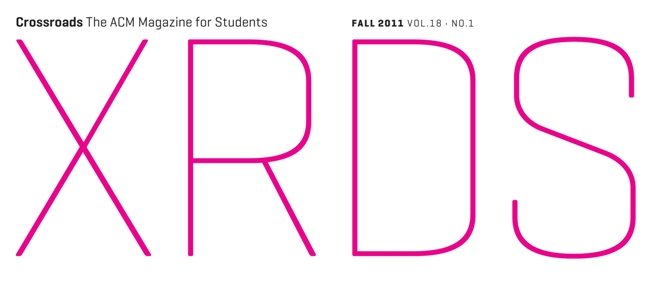Magazine: Letter from the editor
Reading the fine print
FREE CONTENT FEATURE

Reading the fine print
Full text also available in the ACM Digital Library as PDF | HTML | Digital Edition
If you've read through an XRDS article and thought, "I want that guy's job," you might consider going for a Ph.D. That's because most XRDS articles are written by Ph.D.s, or students working on the degree. By the time I finished my undergraduate studies, I had experienced several I-want-that-guy's-job moments. When I realized that the commonality between these people was that they all had doctorates, I knew I had to go to grad school too. If you have one of those moments, there are a few things to take special note of.
People generally think of scholarly papers and articles as a means to convey research results. However, they also provide insights into the authors' motivations, thought processes, work patterns, future musings, and sometimes even life perspectives. For students who are trying to find a field that excites them, to discover a thought process that matches their own, or just plain figure out what being a researcher entails, papers are invaluable. XRDS articles provide a little window into this (often strange) world. We hope each issue inspires a few students to dig a bit deeper and maybe even consider pursing higher degrees.
If something does catch your eye in an issue, the first place to turn is the references section of the article. This will give you an initial reading list of related materials, which will link to other articles, and so on. You'll find the more you read, the more you'll understand the specific elements of the research you liked, and the more you'll hone in on your particular field of interest. Do you like building huge systems, crafting efficient algorithms, designing applications, or studying how people use technology? Think about what excites you within computer science: operating systems, user interfaces, cryptography, mobile computing, artificial intelligence, networking... the list goes on and on.
Also take note of what conferences or journals the articles appear in, and then peruse their respective table of contents. Another great place to get started is our Pointers section (page 43), with links to web resources, software, degree programs, and other leads. For the adventurous, you can try your hand at keyword searches and delve into decades of research archived in the expansive ACM Digital Library. The more you read and poke around, the more informed you'll be, even if you find you "don't want that guy's job," which is just as valuable to know.
The strategy above worked for me. I was a straight computer science geek during my undergraduate studies, and was unfamiliar with human-computer interaction, even though I was dabbling in the field (unknowingly). It wasn't until I started digging around the ACM Digital Library did I finally find a name for my interest. One conference kept popping up over and overthe ACM Annual SIGCHI Conference on Human Factors in Computing Systems, or "CHI" for short. From there I found topics, authors, and universities doing research that wowed and intrigued me. This ultimately helped me compile a list of Ph.D. programs to apply to... and the rest is history.
So, what are you waiting for? Get reading!
Chris Harrison is a Ph.D. student in the Human-Computer Interaction Institute at Carnegie Mellon University. He completed his B.A. and M.S. in computer science at New York University in 2005. Harrison is a recipient of a Microsoft Research Ph.D. Fellowship and is editor-in-chief of XRDS. Before coming to CMU, Harrison worked at IBM Research and AT&T Labs. He has since worked at Microsoft Research and Disney Research. Currently, he is investigating how to "interact with small devices in big ways" using novel sensing technologies and interaction techniques.
©2011 ACM 1528-4972/11/0900 $10.00
Permission to make digital or hard copies of part of this work for personal or classroom use is granted without fee provided that copies are not made or distributed for profit or commercial advantage and that copies bear this notice and the full citation on the first page or initial screen of the document. Copyrights for components of this work owned by others than ACM must be honored. Abstracting with credit is permitted. To copy otherwise, republish, post on servers, or redistribute requires prior specific permission and a fee. Permissions requests: [email protected].
The Digital Library is published by the Association for Computing Machinery. Copyright © 2011 ACM, Inc.
Pointers
Jargon
Electron Microscope: A technology that uses a beam of electrons to illuminate and magnify a subject with far greater resolution than normal optical microscopes.
Functional Magnetic Resonance Imaging: A noninvasive form of BCI that measures the change in blood flow in regions of a subject’s brain and/or spinal cord.


